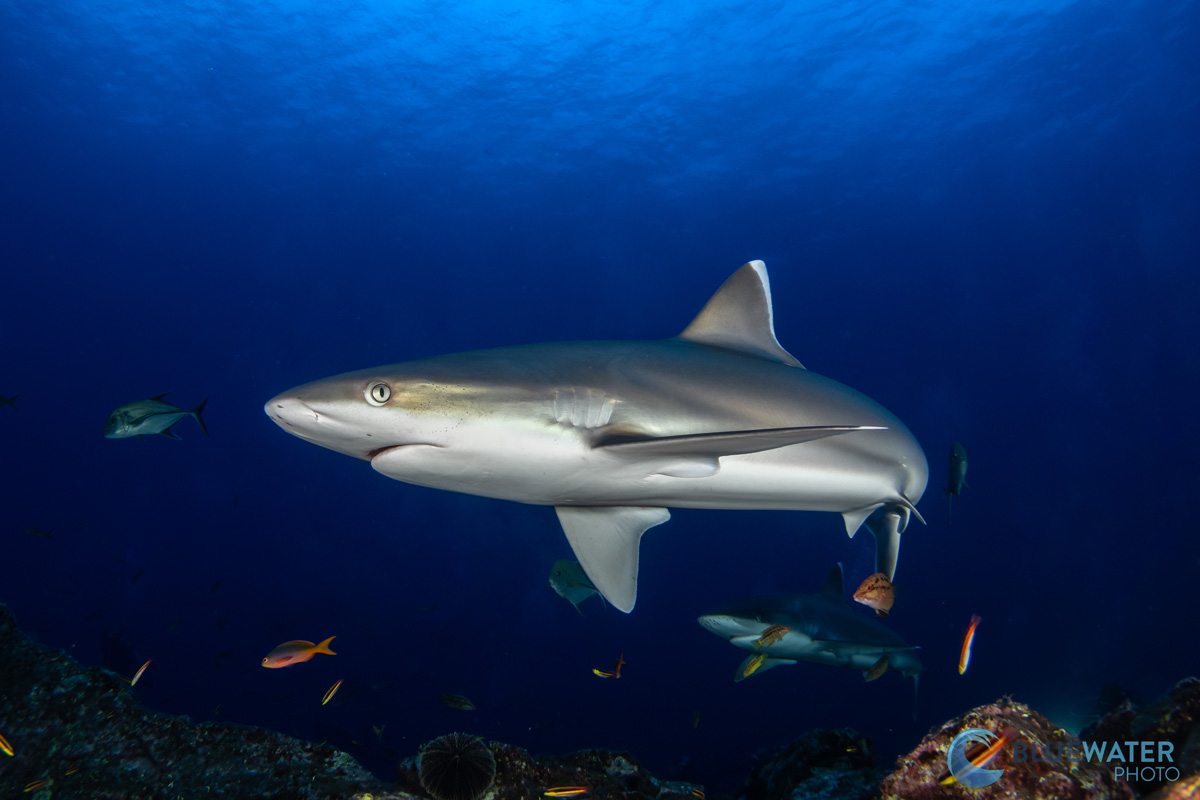Three hundred miles southwest of Mexico’s Baja California Peninsula, the lonely Revillagigedo Archipelago sits adrift in the East Pacific Ocean. More commonly referred to as Socorro after the largest island in the group, these rocky outcrops remain relatively undiscovered despite falling within easy reach of the USA. At first glance, Socorro’s barren volcanic landscape appears uninhabited and devoid of life, however, the island boasts a well-kept secret; beneath the churning Pacific swell, a surprising juxtaposition of spectacular marine life awaits. Exploring the three main islands of Socorro, San Benedicto, and Roca Partida is a career highlight for most divers.
Socorro’s Spectacular Marine Life
Throughout the year, upwellings of cool, nutrient-rich water deliver life-nourishing plankton to Socorro’s steep walls and rocky reefs. This provides the foundation for a flourishing ecosystem that supports an entire network of resident species. Amongst the cracks and crevices of the islands’ submerged fortifications, tiny crustaceans, nudibranchs, octopuses, and eels seek shelter from the constant onslaught of the Pacific Ocean. And while divers may not visit Socorro for its reef life, studies have identified the islands as having the highest diversity of fish and coral communities in the Mexican Pacific. Resident shark species such as the whitetip reef shark can be found in abundance, while huge schools of jack and creolefish create disorientating clouds above the reef.
And yet this thriving aquarium is a mere sideshow to the main attraction. The nutritious currents that encourage so much life also attract vast numbers of visiting pelagic heavyweights to Socorro’s waters. Throughout the year, scores of migratory giants pause to replenish themselves and seek temporary refuge on their journey along the Pacific coast. November and early December bring whale sharks following the plankton blooms, while February and March are optimum months for humpback whale sightings. This is in addition to a constant supply of shark species including Galapagos, silky, oceanic whitetip, and huge schools of scalloped hammerheads. To cap it off, most divers will have some close up encounters with a pod of very friendly dolphins!
Words by Gillian Flaherty, Photos by Nirupam Nigam
But the stars of the show in Socorro’s megafauna bonanza are without doubt the giant Pacific manta rays. Offering perhaps the best manta encounters on the planet, these awesome filter feeders swoop and glide incredibly close to divers who are left completely mesmerized by their easy grace. For those searching for the ultimate manta ray experience, the mantas at Socorro are second to none. Nowhere else do they play in regulator exhausts, passing close overhead time and again as the bubbles tickle their underside. The mantas alone are worth visiting Socorro for.
Accompanying the whole star-studded pelagic roadshow, an entourage of ocean-going gamefish including huge tuna, barracuda, wahoo, marlin, and mackerel add even more interest and excitement. Such a wealth of life out in the blue puts diving Socorro on a par with other big animal destinations such as Galapagos and Cocos Island.
How to Dive Socorro
A combination of remote location and lack of topside facilities means Socorro is only accessible via liveaboard. The main dive season runs from November through to May to coincide with the major pelagic migrations, and boats tend to spend eight to ten nights exploring the islands’ best dive sites. Liveaboards depart from either San Jose del Cabo or Cabo San Lucas at the southern end of Baja California in Mexico, and the transit out to Socorro takes around 24 hours.
There are regular direct flights to Los Cabos International Airport (SJD) from many US cities, making Socorro a very attractive alternative to other big animal destinations. Divers can be on their liveaboard within an hour of landing, and there are currently no covid restrictions in place for entering Mexico, although most boats currently have covid testing requirements for boarding.
Socorro Diving Conditions
This main thing to be aware of is Socorro’s open ocean situation. Most dive sites are exposed and diving is correspondingly challenging. The currents, upwellings, and heavy seas that attract such fantastic marine life also create conditions only experienced divers should tackle. Water temperatures vary from 70 to 74 degrees F during the winter months up to 82 degrees F in the spring and late fall, therefore a thick exposure suit and hood are recommended. Gloves are not permitted by law.
Visibility varies depending on the dive site, weather conditions, and the time of year. The plankton that attracts whale sharks in December can reduce visibility, however, it reaches over 100ft at some sites, in particular at Roca Partida.
If big pelagic action and a non-stop parade of sharks is your type of dive vacation, Socorro is the perfect destination. Look no further than a liveaboard trip to discover everything this awesome island has to offer.
Words by Gillian Flaherty, Photos by Nirupam Nigam


